Transforming a City's
Vacant Spaces
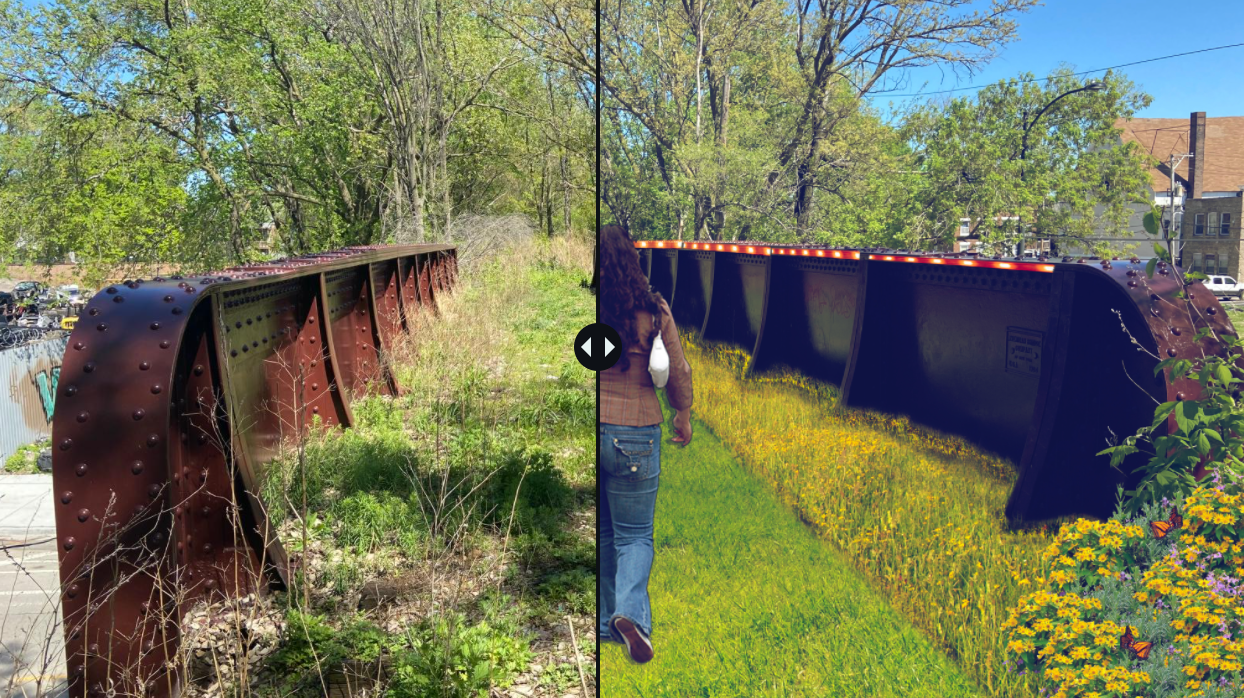
A visualization of the Englewood Nature Trail. Image courtesy of the Englewood Nature Trail
A visualization of the Englewood Nature Trail. Image courtesy of the Englewood Nature Trail
by Rowan Beaird
Every two years, the Chicago Architecture Biennial shows us how design can revitalize communities.
The 2021 edition—The Available City—celebrates a community-led design approach that aspires to transform vacant urban spaces. This year, School of the Art Institute of Chicago (SAIC) faculty members are essential contributors to two projects being spotlighted by the biennial: The Englewood Nature Trail and Borderless Studio. We talk to them about how they’re collaborating with local communities and the power of design.
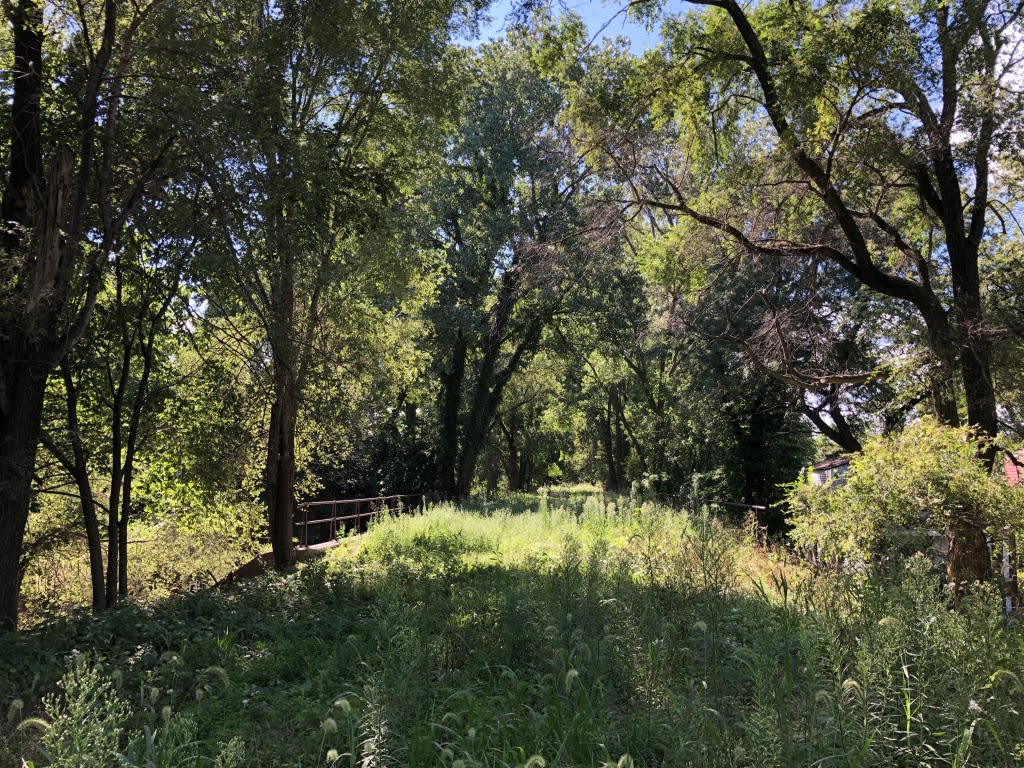
Land that will make up part of the Englewood Nature Trail. Image courtesy of the Englewood Nature Trail
Land that will make up part of the Englewood Nature Trail. Image courtesy of the Englewood Nature Trail
The Englewood Nature Trail
Associate Professor Andres Hernandez and Assistant Professor, Adj. Eric Hotchkiss
In Chicago’s Englewood neighborhood on the South Side, there’s a two-mile stretch of land that feels different than other parts of the city. Previously home to factories and light manufacturing centers, it hasn’t been touched in more than three decades. “It’s just been reclaimed by nature,” shared Bweza Itaagi, the lead sustainable growth steward at Grow Greater Englewood. The towering trees form a sound barrier between the land and the street. Native plants sprawl. Butterflies roam. “It’s this oasis in the middle of Englewood.”
In 2014, Grow Greater Englewood developed the idea to transform this piece of land into a nature trail. Over the past seven years, they’ve been conducting site assessments and deeply engaging the community—from high school students to senior citizens—on the trail’s development. “We invite everyone to the table because they all have different entry points into engagement, but also different things that they value,” shared Assistant Professor, Adj. Eric Hotchkiss, who has been working on developing the trail alongside Associate Professor Andres Hernandez.
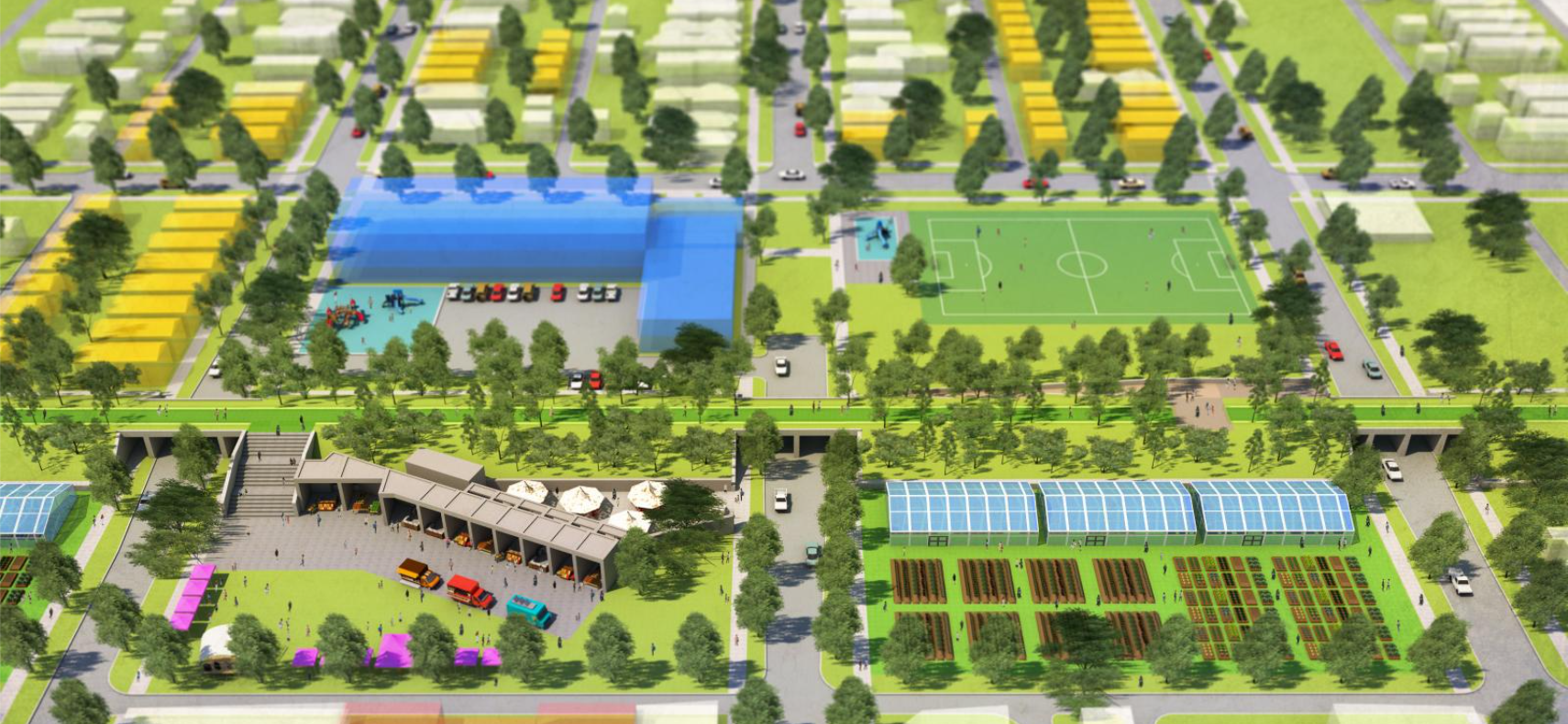
A rendering of the trail. Image courtesy of the Englewood Nature Trail
A rendering of the trail. Image courtesy of the Englewood Nature Trail
“For us, that engagement was a very crucial component that we wanted to spend the most amount of time on,” Itaagi said. “So, we have taken years to have different community engagement strategies and surveys and conversations that mostly have shown that people just want a space where they can walk safely and leisurely within their neighborhood. They want a space that feels still like they're in nature without having to travel far outside of Englewood.”
The plans that they developed aim to preserve as many of the natural elements of the land as possible. They plan to install benches and lighting and give new life to the space surrounding the trail. In their assessment, they learned that there are roughly 3,000 vacant parcels of land within the one-mile radius of the trail. They plan to convert some of these parcels into farm space, and create new areas for community events and programs.
“It's meant to be a community space, a gathering space, but also an educational space. How can we have this outdoor space that serves multiple purposes for multiple types of people?”
“There's lots of different programming possibilities, but we don't want to over program it,” Hotchkiss said. “The community knows what it wants, and they're really good at being resilient and doing things themselves.”
As part of their participation in the biennial, they’ve been connected to the architecture firm Atelier Bow-Wow, who is drafting designs for the entryway for the trail. “It's meant to be a community space, a gathering space, but also an educational space. How can we have this outdoor space that serves multiple purposes for multiple types of people?” Hotchkiss said. The finished design will be exhibited as part of the biennial. “They really beautifully took all of our ideas and visualized them into these incredible designs,” Itaagi said.
When asked about the biennial’s commitment to collective space, both Hotchkiss and Itaagi wanted to emphasize that this idea is nothing new. “I guarantee you right now—there is a group of people in Englewood who is setting up chairs and they're playing chess. Or a group that's set up in another vacant lot, right? They've cut the weeds and … are setting up to have a meal,” Hotchkiss shared. “Collective space is something communities are doing already. We're just trying to implement it in a much grander way.”
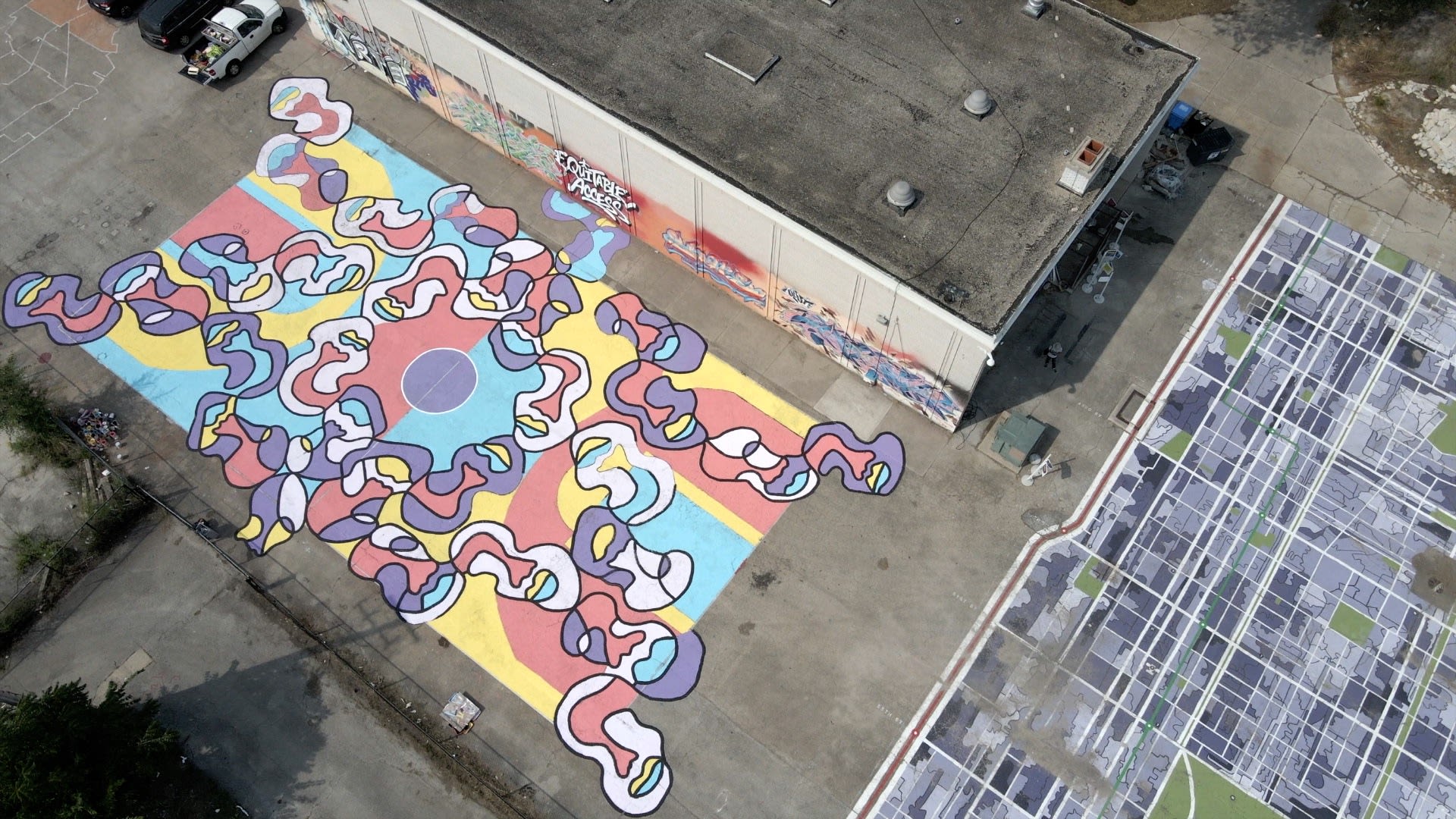
The basketball court at Anthony Overton. Photo: On The Real Film copy
The basketball court at Anthony Overton. Photo: On The Real Film copy
Borderless Studio
Lecturer Paola Aguirre Serrano
In 2013, Chicago Public Schools shuttered nearly 50 schools—the largest mass school closure in US history. The impact on neighborhoods was profound, and now, years later, these vacant school buildings still populate the city. Creative Grounds, an initiative of Borderless Studio, was created in 2016 by Lecturer Paola Aguirre Serrano to explore the potential of unused school grounds in communities. “Creative Grounds started from the question of: How can design and architecture help to repurpose these schools in a more inclusive way? How do we process the transformation equitably?” she shared.
Over the past several years, Creative Grounds has centered its efforts on Anthony Overton Elementary School, located on the city’s South Side. In partnership with neighborhood residents, community organizers, educators, and architects, they’ve used the school’s grounds for various art installations, activations, and workshops. Collaboration is essential to each new project, and they work to be responsive to current needs; during the beginning of the pandemic, parts of the school were used as a food distribution center.
“The ethos that we’re trying to cultivate is that this is a collective space,” Aguirre Serrano said. “I feel like this is how communities thrive—because we understand that nothing can be done as individuals, and that collective space is a result of collective efforts.”
Creative Grounds has been partnering with the biennial since 2017, and this year is no different. Creative Grounds’ current theme is Frame(Works) of Resilience, and it will encompass three projects that the biennial will spotlight, using the Overton Incubator as a venue. The first is a community pop-up market called the Overton Exchange. Located in the school’s parking lot, the market will feature community-led groups; resources; and efforts focused on solidarity, mutual aid, and community care. The second is an evolution of the food distribution center. “We had a lot of pantry goods, but a lot of the asks from residents that came were like, ‘Do you have any fresh greens? Or fresh fruit?’” Aguirre Serrano said. As a result, they’ll be creating a community garden.
The third project will be an art installation on the school’s basketball court. In the past, artists and neighborhood residents have collaborated on artwork touching on pressing issues like the school closings and urban flooding connected to climate change. Three SAIC recent graduates from Aguirre Serrano’s class Process(ing) Transformation—Ruth Levy, Gordon Johnson, and Valerie Wong—have been essential to organizing these projects.
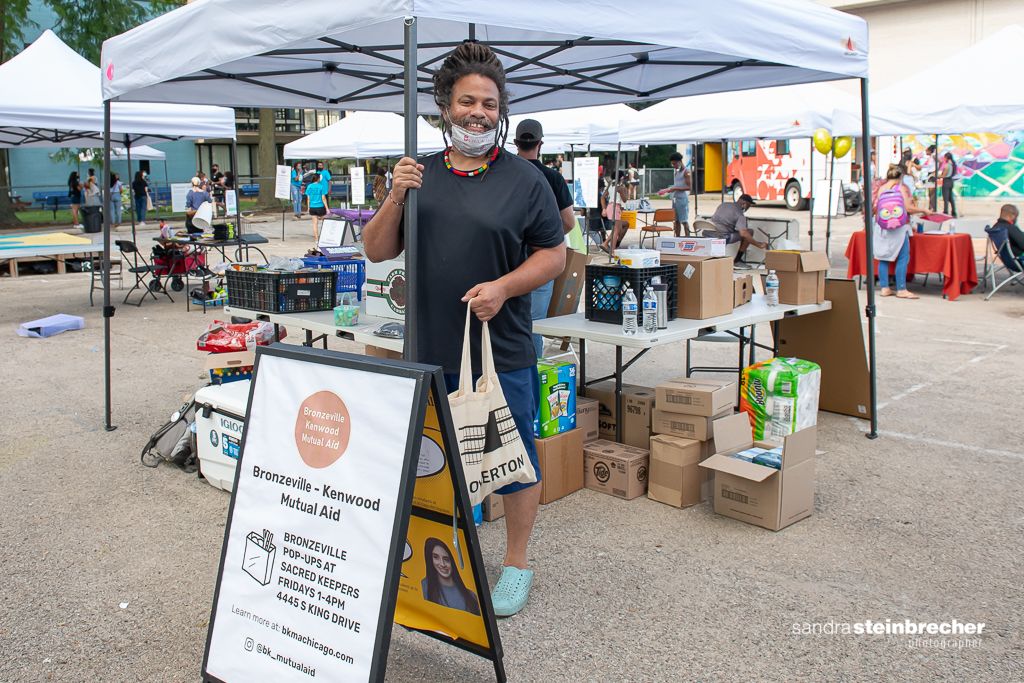
Overton Exchange. Photo: Sandra Steinbrecher
Overton Exchange. Photo: Sandra Steinbrecher
“What we’re doing, basically, is bringing collective visibility to community-led efforts,” Aguirre Serrano shared. “I believe design has power. It reconnects communities with their own power to transform their built environment. I feel, as a designer … I want to be less the one making things, but more being a resource to others to make the changes they want to see happen for themselves.”
The Available City runs from September 17 to October 31, 2021. In addition to the projects spotlighted above, Assistant Professor, Adj. Joseph Altshuler, Lecturer Maya Bird-Murphy, Professor, Adj. Odile Compagnon, Professor Linda Keane, and Lecturer Traci Wile are also serving as biennial learning partners.
As part of the biennial, SAIC’s Homan Square is hosting workshops in North Lawndale with Soil Lab and a reception for Hotchkiss's I AM Project. The Office of Engagement also hosted A Glimpse of What's to Come, an event spotlighting the Central Park Theatre, which staff member Dio Aldridge is helping to restore. ■
